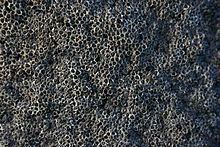Class Maxillopoda Rank Species | Subphylum Crustacea Infraclass Cirripedia Superfamily Chthamaloidea Order Sessilia | |
 | ||
Similar Chamaesipho brunnea, Cellana ornata, Cellana radians, Sypharochiton pelliserpentis, Nerita melanotragus | ||
Chamaesipho columna top 6 facts
Chamaesipho columna is the type species for the barnacle genus Chamaesipho. Originally, species concept, as refined by Darwin472 consisted of C. columna. Spengler's 1790 description included specimens from "Otaheite" (Tahiti), which were far larger than any of the three described species. As Chamaesipho is restricted to Australia and New Zealand, and Spengler's Tahiti material lacked opercular plates, it is no longer included as Chamaesipho. Spengler's written description agrees with Chamaesipho.472 Spengler's Tahiti material is thought to be New Zealand Epopella, mislabeled.
Contents
- Chamaesipho columna top 6 facts
- Description and Discussion
- Nomenclature and Synonymy
- Vernacular Names
- Geographical and Environmental Data
- References
Later authors recognized Chamaesipho columna populations really represented three species. Moore, 1944, recognized a second New Zealand population with sufficient anatomical differences to warrant description as Chamaesipho brunnea. The two species substantially overlap, and are sympatric. Australian Chamaesipho were seen to represent a third species, which was proposed as Chamaesipho tasmanica. Neither New Zealand species occurs naturally in Australia.
Description and Discussion
Adult shells are very small, rostrocarinal diameter of not more than 9 mm in solitary specimens, 4 mm in columnar growth individuals. Height of crowded individuals reaches to 16 mm, 6 in solitary specimens. Shell is whitish, and erodes to show pitting. Juvenile shell wall of 6 plates, becoming four plated by diameter of .5mm, and sutures fuse together, cannot be seen in adult, even when etched with acid. Basis is membraneous.
Opercular plates are deeply interlocked with sinuous articulation, and subject to considerable environmental wear, making large variations in individual appearance and shape.471 Articulation is not nearly as deep as in Chamaesipho brunnea. Interior of scutum shows a wide shallow adductor pit, and small lateral depressor pit. There is a distinct low rounded scutal adductor ridge, in contrast to that of C. brunnea, which has at best poorly developed ridge. Scutal articular ridge, which in chthamaloids is large central lobe on tergal margin, is rounded. In C. brunnea, this lobe is very large and rectangular. Tergum is much narrower than in C. brunnea, with articular margin bearing two rounded relatively shallow re-entrants. Chamaesipho brunnea shows a single very deep re-entrant. Tergal depressor crests are prominent in both species, with fewer (to about 4) in C. columna, versus up to 7 in C. brunnea. Crests are not visible from exterior in C. columna. Neither species shows a tergal spur.
Moore, 1944 provides full descriptions of hard and soft part anatomy for both juvenile and adult stages of Chamaesipho columna.
Nomenclature and Synonymy
Vernacular Names
Locally known as the "column barnacle", after its shell form in crowded colonies.
Geographical and Environmental Data
Chamaesipho columna is found in all New Zealand waters except Chatham Islands. Much of its range overlaps that of C. brunnea, and in those areas, C. columna will be found below the zone of C. brunnea in higher intertidal. In addition, C. columna will colonize areas more protected from direct wave action. Chamaesipho brunnea prefers the highest most exposed areas to wave action. Both species overwhelmingly prefer rocky or shell substrates, rarely wood.
Unlike nearly all other chthamaloids, Chamaesipho columna occasionally enters tidal estuaries, but not as far as to encounter brackish or muddy water.
